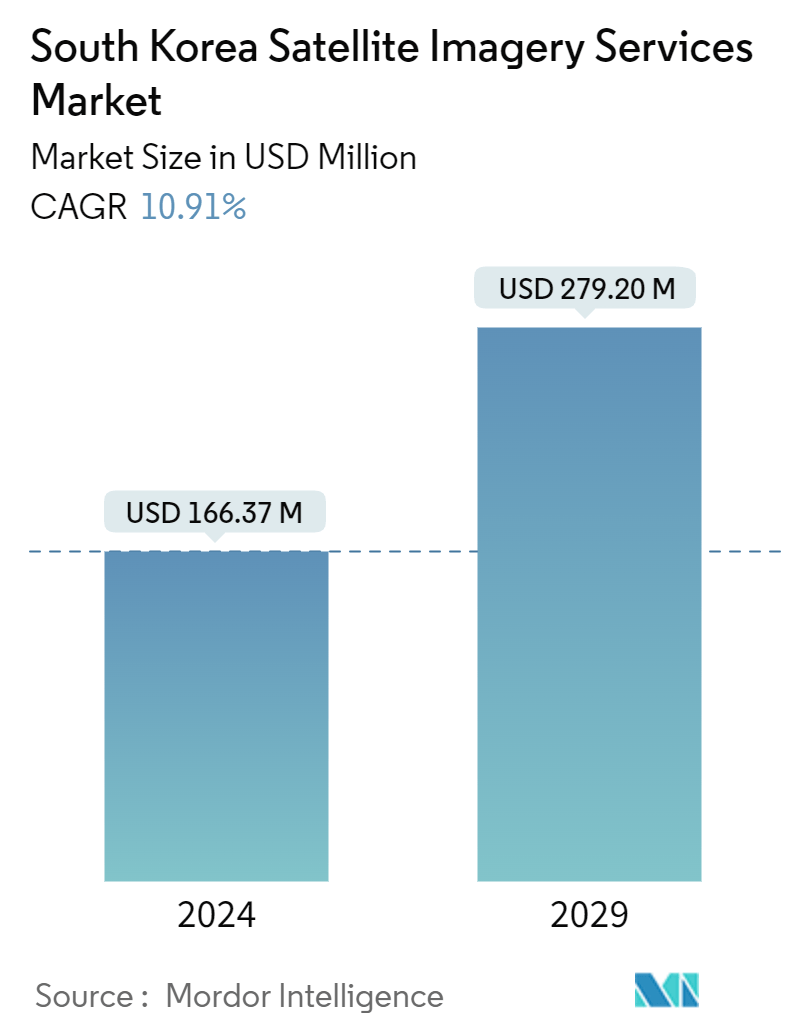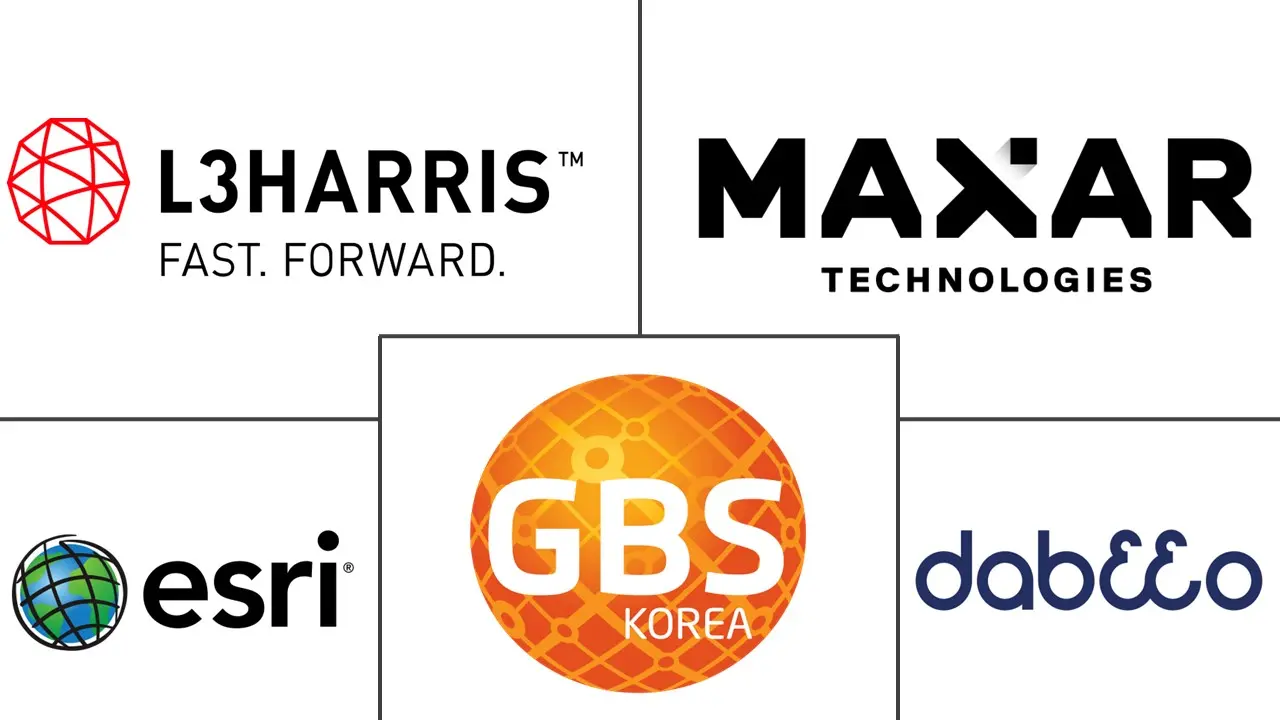Market Size of South Korea Satellite Imagery Services Industry

| Study Period | 2019 - 2029 |
| Base Year For Estimation | 2023 |
| Market Size (2024) | USD 166.37 Million |
| Market Size (2029) | USD 279.20 Million |
| CAGR (2024 - 2029) | 10.91 % |
| Market Concentration | Medium |
Major Players
*Disclaimer: Major Players sorted in no particular order |
South Korea Satellite Imagery Services Market Analysis
The South Korea Satellite Imagery Services Market size is estimated at USD 166.37 million in 2024, and is expected to reach USD 279.20 million by 2029, growing at a CAGR of 10.91% during the forecast period (2024-2029).
The South Korean imagery service market has been experiencing significant growth in recent years. As technology has advanced and become more accessible, there has been a growing demand for imagery services across various industries and sectors.
- Aerial photography and mapping services are widely used in urban planning, real estate, agriculture, and infrastructure development sectors. High-resolution aerial imagery provides valuable data for mapping, 3D modeling, and visualizations, which are essential for decision-making and project planning.
- South Korea is known for its technological advancements, and the imagery service sector is no exception. The country has witnessed the development of high-resolution satellite imagery, unmanned aerial vehicles (UAVs) equipped with advanced cameras, and LiDAR technology, enabling more accurate and detailed mapping and surveying.
- For instance, in December 2022, South Korea released a photo of Pyongyang taken from one of its own satellites after North Korea published imagery of Seoul using what it claimed was a military spy satellite. The released high resolution photo was taken from the lnd satellite No. 1, shows Kim Il-sung Square and its surrounding facilities, including a history museum, an art museum and a department store.
- Another major driver which is boosting the market of satellite imagery service in South Korea is the development of smart city in the country. Imagery services are crucial for gathering and analyzing data, which is essential for smart city development. South Korea has extensively used satellite imagery, aerial photography, and other forms of remote sensing to collect detailed information about urban areas. This data is then integrated with other data sources and processed using artificial intelligence and data analytics techniques to extract valuable insights.
- Furthermore, South Korea has leveraged imagery services for environmental monitoring and management. By analyzing satellite imagery and sensor data, they can monitor air quality, detect changes in vegetation, and manage natural resources more effectively. This enables them to address environmental concerns promptly and develop sustainable practices.
South Korea Satellite Imagery Services Industry Segmentation
Satellite imagery refers to images of the Earth taken from satellites orbiting the planet. These satellites are equipped with various sensors for detecting visible light, infrared light, microwave radiation, and more to craft high-resolution images. These images combine to create visual representations of the Earth, providing new perspectives on climate, geography, and manmade structures.
The South Korea satellite imagery services market is segmented by application (geospatial data acquisition and mapping, natural resource management, surveillance, and security, conservation and research, disaster management, and intelligence), by end-user (government, construction, transportation, and logistics, military and defense, forestry, and agriculture, and other end users).
The market sizes and forecasts are provided in terms of value (USD) for all the above segments.
| By Application | |
| Geospatial Data Acquisition and Mapping | |
| Natural Resource Management | |
| Surveillance and Security | |
| Conservation and Research | |
| Disaster Management | |
| Intelligence |
| By End-User | |
| Government | |
| Construction | |
| Transportation and Logistics | |
| Military and Defense | |
| Forestry and Agriculture | |
| Others |
South Korea Satellite Imagery Services Market Size Summary
The South Korea satellite imagery services market is experiencing robust growth, driven by advancements in technology and increasing demand across various sectors. The market is characterized by the use of high-resolution satellite imagery, unmanned aerial vehicles, and LiDAR technology, which are pivotal for urban planning, real estate, agriculture, and infrastructure development. South Korea's technological prowess has facilitated the development of sophisticated imagery services that support smart city initiatives, environmental monitoring, and military operations. These services are integral for data collection and analysis, enabling informed decision-making and strategic planning in urban development and defense. The market is also bolstered by the country's focus on maritime security, where satellite imagery plays a crucial role in monitoring maritime activities and enhancing naval surveillance.
In the agricultural sector, satellite imagery is transforming farming practices through precision agriculture techniques, allowing for detailed monitoring of crop health and performance. This technology aids farmers in making data-driven decisions to optimize crop yield and resource efficiency. The South Korean government is actively investing in agricultural advancements, further supporting the adoption of satellite imagery in farming. The market is moderately consolidated, with key players like Dtonic Corporation, Bentley Systems, and Maxar Technologies leading the charge. These companies are engaging in strategic partnerships and innovations to enhance their offerings and maintain a competitive edge. Recent developments, such as the launch of commercial-grade satellites and collaborations with international firms, underscore the dynamic nature of the market and its potential for continued expansion.
South Korea Satellite Imagery Services Market Size - Table of Contents
-
1. MARKET INSIGHTS
-
1.1 Market Overview
-
1.2 Industry Attractiveness - Porter's Five Forces Analysis
-
1.2.1 Bargaining Power of Buyers
-
1.2.2 Bargaining Power of Suppliers
-
1.2.3 Threat of New Entrants
-
1.2.4 Threat of Substitutes
-
1.2.5 Intensity of Competitive Rivalry
-
-
1.3 Industry Value Chain Analysis
-
1.4 Assessment of the Impact of COVID-19 on the Market
-
-
2. MARKET SEGMENTATION
-
2.1 By Application
-
2.1.1 Geospatial Data Acquisition and Mapping
-
2.1.2 Natural Resource Management
-
2.1.3 Surveillance and Security
-
2.1.4 Conservation and Research
-
2.1.5 Disaster Management
-
2.1.6 Intelligence
-
-
2.2 By End-User
-
2.2.1 Government
-
2.2.2 Construction
-
2.2.3 Transportation and Logistics
-
2.2.4 Military and Defense
-
2.2.5 Forestry and Agriculture
-
2.2.6 Others
-
-
South Korea Satellite Imagery Services Market Size FAQs
How big is the South Korea Satellite Imagery Services Market?
The South Korea Satellite Imagery Services Market size is expected to reach USD 166.37 million in 2024 and grow at a CAGR of 10.91% to reach USD 279.20 million by 2029.
What is the current South Korea Satellite Imagery Services Market size?
In 2024, the South Korea Satellite Imagery Services Market size is expected to reach USD 166.37 million.

